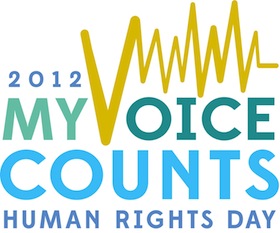 This year’s Human Rights Day celebrated on December 10th highlighted the right for all people, no matter their race, colour, creed, socio-economic stratus, ethnicity or intellectual ability, to claim and enjoy fully their inherent human rights. To have the freedom that comes with being included in their local community as worthwhile people with a voice that is listened to and invited in conversations. The focus of the community is on the quality of the enabling environment not of the level of (dis)ability.
This year’s Human Rights Day celebrated on December 10th highlighted the right for all people, no matter their race, colour, creed, socio-economic stratus, ethnicity or intellectual ability, to claim and enjoy fully their inherent human rights. To have the freedom that comes with being included in their local community as worthwhile people with a voice that is listened to and invited in conversations. The focus of the community is on the quality of the enabling environment not of the level of (dis)ability.
When Edmund Rice took the remarkable step of setting up a school for poor boys in Waterford in 1802, he shook the Irish society of his time to its foundations. Did he realise this? The notion that the poor had a right to education was still a long way off – perhaps 150 years in the future. He did not focus on their antisocial behaviour but on how he might change their environment in ways that would help them to express to realize their full potential.
What Edmund’s heart told him, under the influence of God’s love, was that each student in front of him was of absolute value. They needed a nurturing environment tin which to thrive. Edmund did not need a Universal Declaration of Human Rights to know that. But, after two world wars and two centuries later, the human race still needs reminding of this fundamental insight, the basis of all morality and social justice.
How does an Edmund Rice School honour human rights, flowing as they do from our deep belief in the value of the human person, created and loved by God? Obviously, our schools need to think and feel as Edmund did!
Firstly, each Edmund Rice School can develop a rights-based approach to the way it lives out its vision and mission. So what might a rights-based approach look like from inside the school grounds?
Kofi Annan in 1997, when Secretary General of the United Nations, designated human rights as the cross-cutting issue for all programmes, policies and activities of the family of nations belonging to the UN. If Edmund Rice schools took up the challenge of making human rights the ‘crossing cutting issue’ of the Edmund Rice Schools what would this mean?
There would be recognition that every child has an inalienable right to an education that values full participation and inclusion. There would be a tangible sense of community and interdependence in schools, as well as the promotion of the equality and dignity of every person. Each child would understand both their rights and responsibilities and how they are accountable to the common good of the community.
Schools in the Edmund Rice tradition embracing human rights as a ‘cross-cutting’ set of values take a fresh look at structures, curricula, pastoral care and spirituality. In the long tradition of Edmund Rice the starting place for building relationships and support systems would be the most vulnerable members of the school community. These include groups such as refugees, indigenous or those with special needs, depending on the location and school enrolment policy. How can these groups be fully included in leadership and the decision making process, in cultural and sporting activities, and in the academic and pastoral programs? How can the environment be changed to ensure their inclusion?
In the first place, the school seeks the ideas and opinions of people in these groups; this says their views are highly valued and respected. Every young person, no matter to which group he or she belongs, has the right to express his or her opinion freely and to have that opinion taken into account in matters that affect the whole school community. (This is article 12 of the Convention on the Rights of the Child). What would change in your school community if the planning and major issues were in the first instance brought to the least privileged?
The rights-based approach provides a lens through which to view the effectiveness of the school measured against the ‘touchstones’ of an Edmund Rice education. It invites us to ask different questions. Is the Universal Declaration of Human Rights (1948) and the Convention on the Rights of the Child understood and implemented in the way the school operates? How are the voices of all groups in the community heard, acknowledged and included in decision-making? Are there advocacy groups in the school community who are encouraged to challenge injustice and discrimination? Are staff and students skilled in processes such as dialogue and mediation? What changes need to be made in the school structures to allow new and unheard voices to be listened to?
Edmund Rice schools will continue to become sympathetic and understanding partners of specific groups, whose advocacy efforts seek justice for the voiceless and marginalized. Each class, year level or pastoral care group, may take up specific human rights issues. Perhaps the whole school will partner a specific advocacy project – the rights of children who are HIV+, the rights of street children, the rights of children in jail, the rights of Indigenous children, to name just a few.
Is this the challenge of being a genuinely ‘Inclusive Community’ which not only accepts and welcomes the most vulnerable, but fosters right relationships and commitment to the common good, through vigorous efforts at advocacy?
Peter Harney cfc and Moy Hitchen cfc